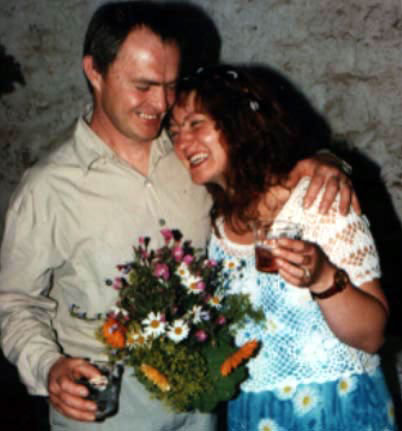We camped there overnight and heard strange loud, chirping noises and Peter went to investigate… he found a pond near us with loads of frogs in that were all croaking and chirruping! The next day he took this picture but not a frog to be seen!

The map we bought in France has paces of interest marked on it and we noticed several called ‘Lanternes des Morts’. We had no idea what these were and even the people we asked at the ‘Rasso’ did not know what they were. On our way to the Brenne we passed through a village called Ciron and I noticed that there was a Lanterne there so we investigated… and found this!

When we eventually found an internet connection I ‘googled’ Lanternes des Morts’ and found an entry in a French version of ‘Wikipedia’ that once translated informed that these dated mostly from medieval times – 10th/11th/12th century and by raising a lamp by a system of pulleys to the top, a light would shine over the countryside to guide the souls of the recently departed home. If my translation is correct, I believe more modern Lanternes were erected in the graveyards dating from the First World war and that there may a few in the UK.
We hunted down a couple more local Dolmens, this one in a field near Montchevrier called the ‘Pierre de la Marthe’

 and this one the Dolmen de Passe-Bonneau near St Benoit-du-Sault.
and this one the Dolmen de Passe-Bonneau near St Benoit-du-Sault. 
We spotted this statue of Jeanne D'Arc as we passed through Orsennes.
We also found another Lanternes, this one is at St Agnant-de-Versillat just North of the town of La Souterraine.

This one is actually in a graveyard and unlike the one at Ciron this one is hexagonal.
We walked round the graveyard and spotted this memorial plaque on the grave belonging to Albert Labrousse.

It says … ‘To the memory of the martyr Albert Labrousse born 9 November 1896 arrested by the traitors of Vichy assassinated on the 2nd of August 1944 in a torture wagon by Hitler’s monsters’. Strong stuff eh! For those who don’t know Vichy is a large town in the Allier district of the Auvergne region in Central France that collaborated with the Germans during the war.

This one is actually in a graveyard and unlike the one at Ciron this one is hexagonal.
We walked round the graveyard and spotted this memorial plaque on the grave belonging to Albert Labrousse.

It says … ‘To the memory of the martyr Albert Labrousse born 9 November 1896 arrested by the traitors of Vichy assassinated on the 2nd of August 1944 in a torture wagon by Hitler’s monsters’. Strong stuff eh! For those who don’t know Vichy is a large town in the Allier district of the Auvergne region in Central France that collaborated with the Germans during the war.































































